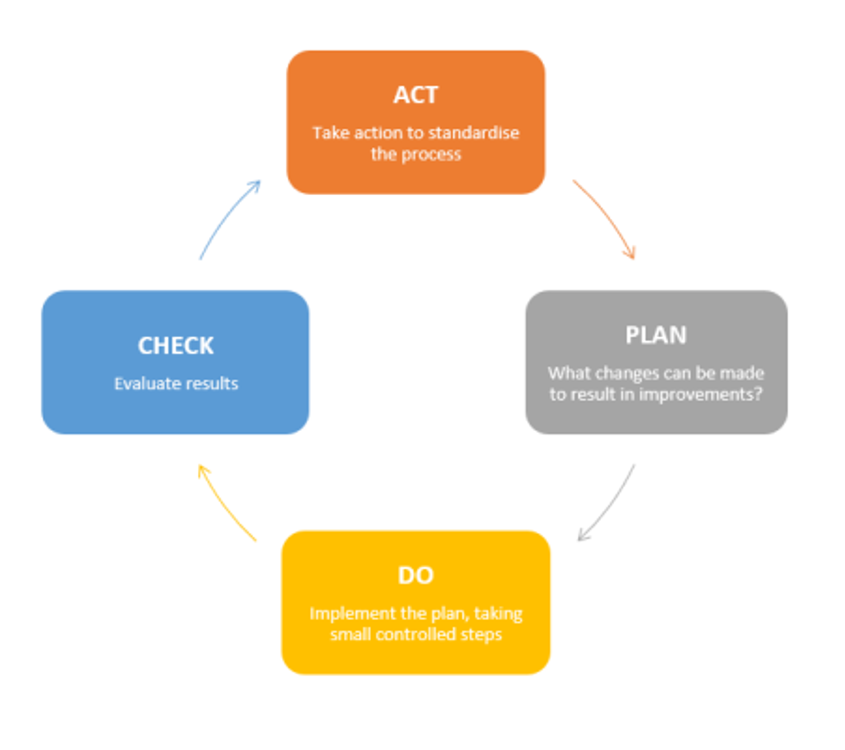Managing and continuously improving quality is the core business of every service provider. Quality management is the action you take to make sure that you always provide the best possible service to your clients. It involves:
- Evaluating your services to ensure they align with performance indicators contained in relevant standards;
- Listening to clients, workers and other stakeholders, and valuing their feedback;
- Understanding what is working well;
- Identifying where improvements are needed; and
- Taking action in order to best meet the needs of clients, workers and other stakeholders.
All major sets of Standards require organisations to have effective quality management and continuous improvement systems in place.
The quality improvement process
Quality improvement is not a singular action. It requires a cycle of continuous improvement, in which you are reviewing your systems, services and processes to evaluate whether you are providing the best possible service to each client.
This cycle is commonly known as the ‘Plan/Do/Check/Act’ cycle and follows four key stages.

Plan:
The planning stage involves evaluating the current state of your organisation and identifying where improvements can be made. In this phase, you should reflect on how you are delivering the services you are providing, your organisation’s compliance with relevant Standards, and feedback and complaints received to determine areas for improvement. Any incidents and near misses that have occurred should also inform your evaluation. The results of this evaluation should be used to plan ways that your service provision can improve, set goals and identify actions to put the plan into practice.
Do:
The next step of the quality improvement cycle is to action your planned changes. This could involve implementing improvements in stages, or testing variations of a planned change to determine the best solution in practice. Relevant stakeholders should be informed of the changes, and what that could mean for them. Adequate resources should be allocated for the purpose of executing the changes successfully, whether that involves extra funding, increased staffing, or more time. It is important that you document the decisions made during this stage, as this data will be used in the next stage of the process.
Check:
During the checking stage, you should be analysing both qualitative and quantitative results from the changes, to determine whether they are achieving the expected outcomes and resulting in better services. Feedback from stakeholders should be sought on their experiences with the changes, as well as any comments they have on further improvements. You should consider reflective questions during this stage to aid evaluation, such as:
- Are the improvements delivering the outcomes as we intended?
- What were the major gaps in our service delivery from our planning process, and have we addressed these gaps?
- Are there any unforeseen outcomes from the changes?
- Are there further improvements we can make, or can we make the process more efficient?
Act:
In this part of the cycle you should decide whether or not to implement the changes based on your evaluation. If the evaluation results demonstrate the changes were not successful, you should revert back to the planning stage to repeat the process and determine a new plan that is based on learnings from the unsuccessful trial.
If the results do show improvements meeting or exceeding your established goals, you should implement the changes and incorporate them into your regular service delivery. You should inform all stakeholders of the changes, including the differences between the old and new procedures, and ensure that all workers are trained in the new processes. Make sure you also update your policy and procedure documents where appropriate, to reflect the changes you’ve implemented.
Feedback, Complaints, Incidents and Near Misses
One of the most important ways you can gather information about the services you provide is through the information you receive from stakeholders, including workers, clients and their support people. Efficient and accessible feedback and complaints mechanisms ensure that those who are impacted can easily communicate their opinions and experiences with the service. In particular, if there is a lived experience disconnect between your clients and decision-makers in your organisation (for example services for children or young people), feedback is an important way to broaden perspectives in the quality management process.
In addition, encouraging clients to work in collaboration with your organisation to tailor services to their unique needs allows you to both provide the best possible service to your clients , as well as meet wider standards obligations. The requirements in many sets of standards include partnering with clients and providing culturally competent services for each individual. Meeting these standards requirements is part of consistently providing the best possible service to your clients and ensuring quality care.
So, what does a good quality management system look like?
An effective quality management system underpins your organisation’s approach to service delivery, and provides the framework for how you deliver quality and safe services for each individual. Quality management should be incorporated as a core facet of the service and be explained clearly in your quality management policies and procedures, as well as policies on related areas.
Your quality management system should:
- Be founded on core policies and procedures that are communicated and understood across your organisation, so that your approach and processes are transparent to everyone, set clear expectations and responsibilities for workers and the organisation, and are consistently followed;
- Be supported by other, related policies and procedures covering areas such as:
- risk management;
- compliance monitoring;
- complaints management; and
- incident reporting
- Be integrated with your Standards compliance status;
- Allocate responsibilities to team members for identified improvements; and
- Be easy to manage, and provide you with up-to-date reports on compliance, improvements identified and how you are tracking towards achieving them.
In conclusion, having a good quality management system is important for organisations to ensure they are providing the best possible services for their clients as well as fulfilling their standards obligations.
Improving your quality management system with SPP
SPP has a wide variety of information sheets and templates available to help you reach your quality management goals, from a template quality improvement register and quality improvement plan to a sample quality management and continuous quality improvement policy. We also have a “Towards Best Practice” self-assessment module on Continuous Improvement.
In addition, we have a range of resources on related topics like risk, complaints, and incidents support the delivery of quality service.
Need QMS resources?
Take out an SPP trial to see our quality management resources and more!


